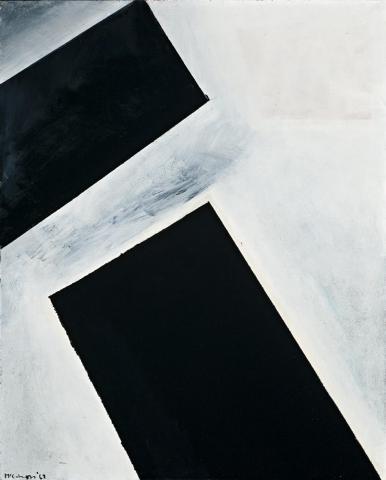GATE, 1962
Colin McCahon
enamel on board
76.0 x 61.5 cm
signed and dated lower left: McCahon ‘62
Gate series
Gow Langsford Gallery, New Zealand (label attached verso)
Martin Browne Fine Art, Sydney
Private collection, New South Wales
Brown, G.H., Colin McCahon, Artist, A.H. & A.W. Reed Ltd, Wellington NZ, 1984, pp. 60, 121 – 130, 214
Bloem, M., & Browne, M., Colin McCahon: A Question of Faith, Stedelijk Museum, Amsterdam & Craig Potton Publishing, New Zealand, 2002, pp. 194–198
The Colin McCahon Database and Image Library # cm001471
In each of the Gates McCahon pursued a two-fold objective. In technical terms he explored his ideas about abstraction and, in particular, the challenge he had posed himself of how he might bring another dimension to the two-dimensional picture plane. The source of the Gate paintings' structure lay in the ideas and precedents of Braque, Gris and Mondrian which had already fascinated McCahon for some years. The opposition of dark forms and the white field - the latter representing nothingness, the space beyond, or light coming through darkness - combined with the strong diagonals, which by implication stretch beyond each painting itself, were the result of McCahon's notion of obstructions and the possibility of 'a way through' the picture plane. Reflecting on Braque's use of pictorial space, McCahon commented admiringly 'there is nothing enclosed, there are ways through', where 'you can look... into infinity.'
On a broader spiritual and philosophical level, the Gate paintings reflected McCahon's meditations on the world around him and, specifically, the enormous obstacles to human progress and happiness that seemed to be posed by the threat of nuclear holocaust at this time - the peak era of the Cold War - and the necessity for mankind to find 'a way through' these threatening situations. The structure of each image rests on the placement of rectangular shapes on the picture plane in such a way as to leave a gap between them into the pictorial space beyond...'1 'These dark, formalised shapes can be likened to two converging walls which, as they move closer, restrict the area in which there is room to manoeuvre. As the two walls squeeze in upon the future of humanity, the gap that still exists between these converging walls becomes the gate that opens a way of escape from this entrapment.'2
As John Caselberg poignantly reflected in his introduction to the exhibition catalogue accompanying the M.T. Woollaston & McCahon touring retrospective in 1963, 'The great Gate series of panels on nuclear weapons concerns the destiny of man. Because of so much newness and scalding truth and faith, we may shield ourselves from the beauty of these pictures and the call to action which all such beauty must contain. But if we ourselves work; if we inspect the paintings searchingly, patiently, fearlessly, with open minds and honest hearts, then, transported by the resounding music of their great shapes, subtle colours, space and light always encompassing the dark, beyond the cyclones of change and ruin girdling creation now' we may by grace see. Only a change of heart can let mankind enter the kingdom of tomorrow. The purpose of these paintings is to change our hearts.'3
1. Bloem, M. & Browne, M., Colin McCahon: A Question of Faith, Stedelijk Museum, Amsterdam & Craig Potton Publishing, New Zealand, 2002, p. 195.
2. Brown, G., Colin McCahon: Artist, A.H. & A.W. Reed, Wellington, 1984, p. 122.
3. Caselberg, J., 'Introduction', A Retrospective Exhibition: M.T. Woollaston - Colin McCahon, Auckland City Art Gallery, New Zealand, 1963, pp. 5-6.
VERONICA ANGELATOS
